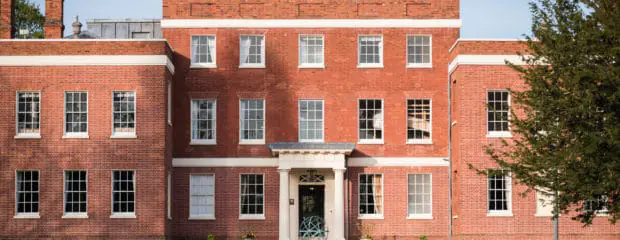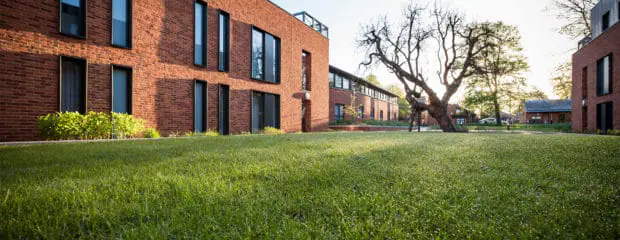Grounds and wetlands
Over 125 acres of parkland and wetlands
The Campus grounds are something to marvel at. The 100-acre parkland of Hinxton Hall provides a range of natural spaces, from beautifully curated flowerbeds and lawns, to impressively large trees and a Wetlands Nature Reserve. Attendees at conferences and events here on-site are invited to explore the wonderful outdoor space available.
The Orchard
360 interactive image of our orchard
Originally built with the Hall, the orchard was a kitchen garden, which supplied the main house with fresh produce all year round. The garden also contained an orangery and glasshouse.
Today, the orchard consists mostly of fruit trees – all apples but one pear tree. Tree varieties include Worcester Pearmain, Cox’s Orange Pippin and Laxton Superb. We also have several figs, which are wall trained and greengages.
In Spring time, the orchard bursts into life, with the arrival of snowdrops, daffodils and crocuses. The trees are pruned every winter, to encourage maximum fruiting – this leads to lots of blossom in the spring for our pollinators. With warm, sunny days, the scent is amazing. A lot of the planting in the orchard borders, is tailored to our pollinators; it’s important to encourage these, as they will improve the fruiting. Lilies, sedums and hellebores, ensure there is a supply of food for bees, flies and butterflies, over at least 9 months of the year – this is also helped by pruning methods which can delay flowering until later in the year.
The main maintenance takes place between late December and late February, with the winter pruning of the fruit trees. This pruning is essential as it encourages fruiting buds but more importantly, it keeps the trees healthy and reduces the need to use harmful sprays to control pests and diseases.
Since 2017, we no longer cut all of the grass area around the trees. The longer grass not only benefits the trees by retaining moisture and preventing machinery damaging the bark; the sward also shows ‘rewilding’ in action. By reducing our cutting, we have seen an increase in cowslips, ox eye daisy, dog violets and red deadnettle – amongst other wild plants. Consequently, Meadow Brown and Common Blue butterflies have been seen, along with various damselflies.
The choice of plants, the fruit trees, the long grass and the maintenance schedule have helped the orchard to become an eco-system of its own.
For the future, there are plans to turn it back to more of a Victorian kitchen garden, with more herbs and different, ornamentally trained fruit trees. Not only will more provision be made for pollinators but invertebrates are also vital, as many predate on our orchard pests – so nesting areas and over wintering areas will be increased. However, what will not change, is the desire to encourage our local wildlife to share the orchard space with us – not only benefiting them but also, to allow us to engage with our biodiversity.
The Wetlands Nature Reserve
The Wetlands Nature Reserve is a six-hectare (15-acre) area created in 2005 to act as a natural flood attenuation mechanism and to create a new and diverse natural habitat, open for all to enjoy via a public footpath linking the Campus with the local villages of Hinxton and Ickleton.
The Reserve consists of a mosaic of habitats including ponds, grassland, woodland, hedgerow, riverbanks and specimen trees. These habitats make a valuable contribution to enhancing the local environment, as well as an important open space for people to visit.
The River Cam and riverbank form a wildlife corridor linking the Wetlands Nature Reserve to the countryside beyond. The mixture of dense bramble and scrub, open grassland and mature willows provides a varied environment for wildlife. Otters have occasionally been seen and kingfishers have nested in an exposed section of riverbank.
Grasslands rich in wildflowers provide cover, shelter and food for a wide range of invertebrates and other fauna, including amphibians, reptiles, small mammals and ground-nesting birds. Meadows are a nature conservation priority, because 98% have been lost in the past century.
One large and two smaller ponds (that seasonally merge) were planted with a range of aquatic and marginal plants. Water levels are maintained by rainfall and a pipe allowing water to flow from the river. Several wetland birds breed and use the ponds over winter including moorhen, water rail, reed bunting and snipe. Grass snakes, frogs, toads and smooth newts also breed and 15 species of dragonfly have been recorded.
The reserve is managed by a Community Conservation Group comprising representatives from Hinxton and Ickleton villages and staff members from the Campus, with strategic support from the the local Wildlife Trust and the Wellcome Genome Campus.



